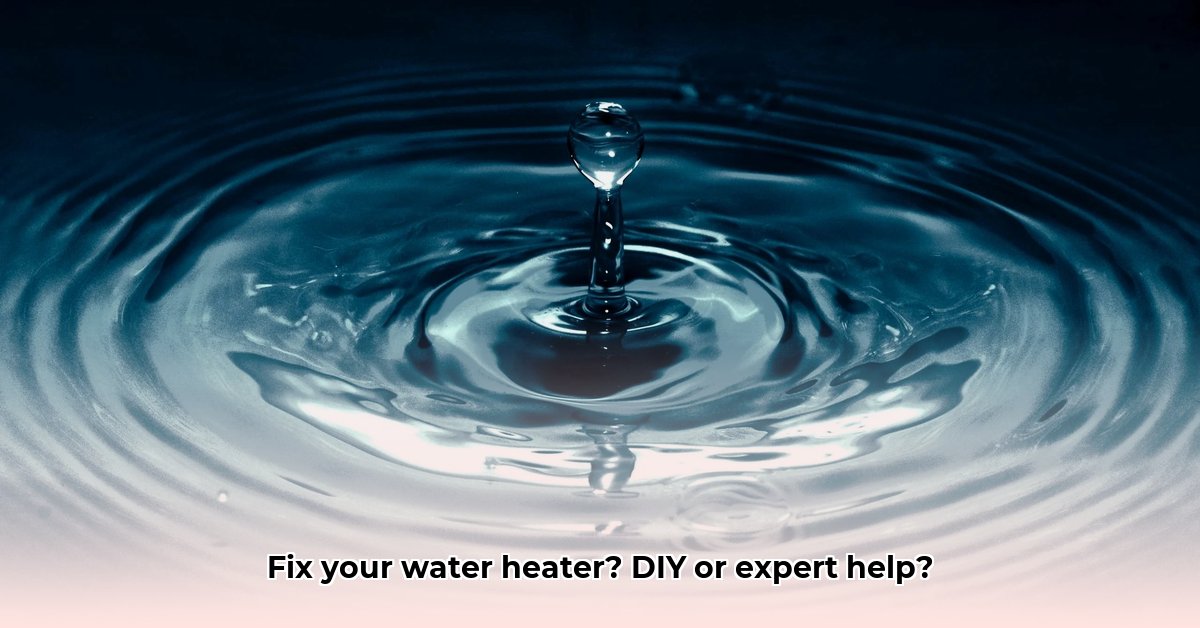Dealing with a temperamental water heater? No hot water is a real bummer, right? This guide will help you troubleshoot common water heater problems, whether it’s a leak, weird noises, or just not enough hot water. We’ll walk you through simple fixes you can probably do yourself, explain when it’s time to call a professional, and show you how to keep your water heater running smoothly for years. Learn about water heater heat-up times here. Let’s get that hot water flowing again!
Diagnosing Common Water Heater Issues
A temperamental water heater can be a homeowner’s nightmare. But don’t worry; many common water heater issues are easily diagnosed and even fixed yourself, saving you time and money on unnecessary repairs. Other problems require the trained eye and expertise of a professional. This guide will help you determine the difference and take the appropriate action.
Understanding Your Water Heater’s Operation
Before you start troubleshooting, take a moment to understand how your water heater works. Knowing the type – electric or gas – is crucial because the potential problems and solutions often differ significantly.
- Electric Water Heaters: These use electric heating elements to warm the water. Problems often stem from tripped circuit breakers, faulty thermostats, or burned-out heating elements.
- Gas Water Heaters: These use a gas burner to heat the water. Common issues include pilot light problems, faulty thermocouples, or gas supply issues.
A quick visual inspection is always a good first step. Look for anything unusual:
* Is there any visible leaking or signs of corrosion?
* Are there any strange noises coming from the unit?
* Is the hot water temperature consistent, or does it fluctuate?
These initial observations will guide your troubleshooting efforts.
The Mystery of the Missing Hot Water
No hot water is a common complaint. Let’s investigate some possible causes.
- Check the Thermostat: Ensure the thermostat is set to a reasonable temperature. The U.S. Department of Energy recommends 120°F (49°C) for energy efficiency and safety. If it’s set too low, simply increase the temperature. Wait a few hours and check again.
- Electric Water Heaters:
- Check the Circuit Breaker: Look for a tripped breaker in your electrical panel. If tripped, reset it. If it immediately trips again, there may be a short circuit requiring professional attention.
- Check the Heating Elements: If the breaker isn’t tripped, one or both of the heating elements may have failed. This usually requires testing with a multimeter and replacement by a qualified electrician.
- Gas Water Heaters:
- Inspect the Pilot Light: If the pilot light is out, relight it following the instructions on the water heater. If it won’t stay lit, the thermocouple may be faulty.
- Check the Gas Valve: Make sure the gas valve is fully open.
Dealing with Leaks: Tracking Down the Source
Water heater leaks require immediate attention to prevent water damage and potential mold growth.
- The Connections: Check the inlet and outlet pipes for any signs of leaks. Tighten any loose connections with a wrench. If the connections are corroded, you may need to replace them.
- The Pressure Relief Valve: This valve is designed to release pressure if it gets too high inside the tank. If it’s constantly leaking, it may indicate a problem with the valve itself or excessive pressure in the tank.
- The Tank Itself: If the leak is coming from the body of the tank, it’s a sign that the tank is corroded and needs to be replaced.
Ignoring leaks will only worsen the situation and can lead to significant water damage.
Sediment Buildup: The Silent Efficiency Killer
Over time, mineral deposits from your water can accumulate inside the water heater, forming sediment. This reduces efficiency, increases noise, and can even damage the tank. Regular flushing helps remove sediment and extends the life of your water heater.
Flushing Your Water Heater: A Step-by-Step Guide
- Safety First! Turn off the power supply to your water heater (electricity or gas).
- Cool Down: Allow the water in the tank to cool completely to avoid scalding. This may take several hours.
- Connect the Hose: Attach a garden hose to the drain valve located near the bottom of the tank. Run the hose to a safe drainage area (e.g., a basement floor drain or outside).
- Drain and Flush: Open the drain valve and allow the water to drain completely. Be prepared for a large volume of water. Once drained, briefly open the cold-water inlet valve to stir up any remaining sediment and flush it out.
- Close and Refill: Close the drain valve securely. Turn on the cold-water inlet valve and allow the tank to refill completely. You’ll hear air escaping from the faucets as the tank fills.
- Restore Power: Once the tank is full, restore the power supply.
Noisy Water Heater
Strange noises emanating from your water heater could indicate several issues:
- Popping or Rumbling: This often indicates sediment buildup on the bottom of the tank. The noise is caused by water bubbling up through the sediment as it is heated. Flushing the tank (as described above) usually resolves this issue.
- Whining: A high-pitched whining noise could indicate a restriction in the water flow, such as a partially closed valve or a kink in the water supply line.
- Banging: This could be caused by water hammer, a phenomenon where water suddenly changes direction in the pipes, creating a loud banging noise. Installing water hammer arrestors can help solve this problem.
Preventative Maintenance: A Little Care Goes a Long Way
Regular maintenance is key to preventing major water heater problems and costly repairs.
- Annual Flushing: Perform an annual flush to remove sediment buildup.
- Anode Rod Inspection: The anode rod is a sacrificial metal rod that protects the tank from corrosion. Inspect the anode rod every few years (or as recommended by the manufacturer) and replace it if it’s heavily corroded.
- Temperature and Pressure Relief Valve Test: Test the temperature and pressure relief valve annually to ensure it’s functioning correctly.
- Insulation: Insulate your water heater tank and hot water pipes to reduce heat loss and save energy.
When to Call in the Experts: Knowing Your Limits
While many water heater issues are DIY-friendly, some require the expertise of a licensed professional.
- Major Leaks: A tank leak is a serious problem that requires immediate attention. Contact a plumber for replacement.
- Gas Leaks: Gas leaks are extremely dangerous and should only be handled by qualified gas professionals.
- Electrical Issues: If you’re not comfortable working with electricity, call a licensed electrician.
- Complex Repairs: If you’ve tried the simple troubleshooting steps and the problem persists, it’s best to consult a professional.
DIY Risk Assessment
| Component/Issue | Risk Level | Mitigation |
|---|---|---|
| Electrical Shock | High | Turn off power; use non-contact voltage testers; always seek professional assistance if unsure. |
| Gas Leaks | High | Call a gas professional immediately if you suspect a leak; evacuate the area. |
| Scalding Hot Water | Medium | Carefully check the temperature setting and handle with caution whilst the water is cooling. |
| Tank Rupture | High | Regular inspections, timely replacement if necessary; observe closely for any bulging or signs of weakening. |
| Incorrect Repair Attempts | Medium | Only attempt repairs you’re completely confident in; if uncertain, call a pro; avoid any attempt that involves major alterations of the water heating system. |
Remember, DIY repairs can save money, but safety should always come first! Use this guide as a resource, but don’t hesitate to contact a qualified professional when needed. Proper maintenance can significantly extend the life of your water heater and prevent costly repairs down the road.
Troubleshooting Gas Water Heater Pilot Light Problems
Key Takeaways:
- Pilot light outages can stem from a faulty thermocouple, clogged pilot orifice, or issues with the gas supply.
- Simple solutions often involve cleaning or adjusting components, but complex problems necessitate professional intervention.
- Safety is paramount; gas leaks are a significant hazard.
Understanding Your Water Heater’s Ignition System
Before troubleshooting, determine the type of gas water heater you have. Older models have a standing pilot light, while newer models may utilize electronic ignition. This will impact the appropriate troubleshooting steps.
Older models require manually relighting the pilot. Newer models use a spark or glow plug to ignite the gas. If the pilot won’t light, the problem could be a faulty igniter, a dirty flame sensor, or an issue with the control board.
Troubleshooting a Pilot Light That Won’t Stay Lit
- Safety First: Turn off the gas supply to the water heater.
- Check the Gas Supply: Ensure the gas valve is fully open and that there’s gas flowing to the heater.
- Inspect the Thermocouple: The thermocouple is a safety device that shuts off the gas supply if the pilot
- How to Stop Apps From Running in the Background to Boost Your - December 1, 2025
- How To Move Apps On Your Droid For Better Organization - November 30, 2025
- How to Move Apps on Android for Better Organization - November 29, 2025










